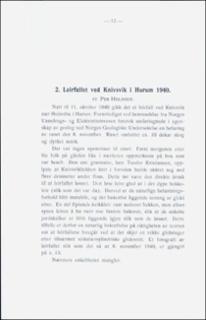| dc.contributor.author | Holmsen, Per | |
| dc.coverage.spatial | 18142 Drøbak | |
| dc.date.accessioned | 2020-08-26T12:39:48Z | |
| dc.date.available | 2020-08-26T12:39:48Z | |
| dc.date.issued | 1946 | |
| dc.identifier.uri | https://hdl.handle.net/11250/2674571 | |
| dc.description.abstract | In the night preceding to October 11th, 1940, a clay-slide took place by Knivsvik near Drammen. This was a typical clay-slide; some liquid clay (\"Kvikkleire\") flowed down a brooklet called Knivsvikbekken. Most of the displaced territory, however, only settled in the way shown on the photo. This phenomenon supports the theory of \"cylindric sliding surfaces\". Further detailes are lacking. | |
| dc.language.iso | nor | |
| dc.relation.ispartofseries | NGU (167) | |
| dc.rights | Navngivelse 4.0 Internasjonal | |
| dc.rights.uri | http://creativecommons.org/licenses/by/4.0/deed.no | |
| dc.subject | AVSETNING | |
| dc.subject | LEIR | |
| dc.subject | SKREDAVSETNING | |
| dc.subject | SKREDFORM | |
| dc.subject | KVIKKLEIRE | |
| dc.subject | GEOLOGISK RISIKO | |
| dc.title | Leirfallet ved Knivsvik i Hurum 1940. | |
| dc.type | Journal article | |
| dc.description.localcode | 35462 | |
| dc.source.pagenumber | 12-13 | |

